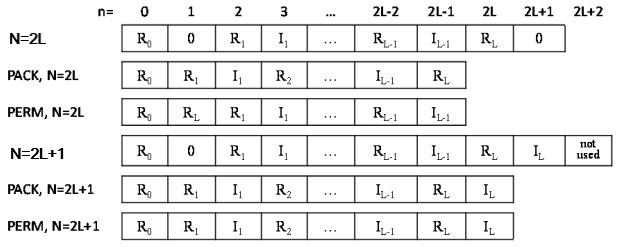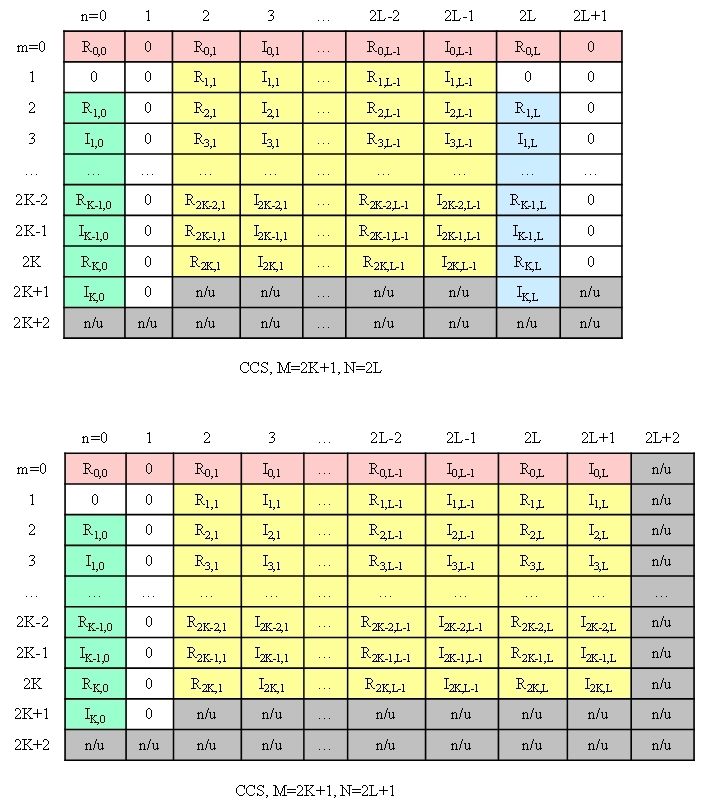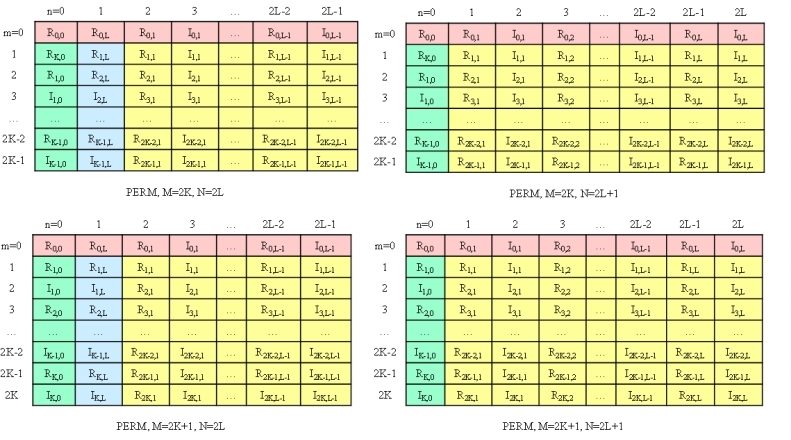Visible to Intel only — GUID: GUID-F65C2255-963E-429F-9E74-99DFBCE1526F
Visible to Intel only — GUID: GUID-F65C2255-963E-429F-9E74-99DFBCE1526F
DFTI_PACKED_FORMAT
The result of the forward transform of real data is a conjugate-even sequence. Due to the symmetry property, only a part of the complex-valued sequence is stored in memory. The DFTI_PACKED_FORMAT configuration parameter defines how the data is packed. Possible values of DFTI_PACKED_FORMAT depend on the values of the DFTI_CONJUGATE_EVEN_STORAGE configuration parameter:
DFTI_CONJUGATE_EVEN_STORAGE=DFTI_COMPLEX_COMPLEX.
The only value of DFTI_PACKED_FORMAT can be DFTI_CCE_FORMAT. You can use this value with transforms of any dimension. For a description of the corresponding packed format, see DFTI_CONJUGATE_EVEN_STORAGE.
DFTI_CONJUGATE_EVEN_STORAGE=DFTI_COMPLEX_REAL.
DFTI_PACKED_FORMAT can be DFTI_CCS_FORMAT, DFTI_PACK_FORMAT, or DFTI_PERM_FORMAT. You can use these values with one- and two-dimensional transforms only. The corresponding packed formats are described below.
Although DFTI_CONJUGATE_EVEN_STORAGE=DFTI_COMPLEX_REAL is the default setting for the DFTI_REAL forward domain, avoid using this storage scheme because it is supported only for one- and two-dimensional transforms, is incompatible with storage schemes of other FFT libraries, and will be deprecated in future.
DFTI_CCS_FORMAT for One-dimensional Transforms
The following figure illustrates the storage of a one-dimensional (1D) size-N conjugate-even sequence in a real array for the CCS, PACK, and PERM packed formats. The CCS format requires an array of size N+2, while the other formats require an array of size N. Zero-based indexing is used.

The real and imaginary parts of the complex-valued conjugate-even sequence Zk are located in a real-valued array AC as illustrated by figure "Storage of a 1D Size-N Conjugate-even Sequence in a Real Array" and can be used to reconstruct the whole conjugate-even sequence as follows:
real :: AR(N), AC(N+2)
...
status = DftiSetValue( desc, DFTI_PACKED_FORMAT, DFTI_CCS_FORMAT )
...
! on input: R{k} = AR(k)
status = DftiComputeForward( desc, AR, AC ) ! real-to-complex FFT
! on output:
! for k=1 … N/2+1: Z{k} = cmplx( AC(1 + (2*(k-1)+0)),
! AC(1 + (2*(k-1)+1)) )
! for k=N/2+2 … N: Z{k} = cmplx( AC(1 + (2*mod(N-k+1,N)+0)),
! -AC(1 + (2*mod(N-k+1,N)+1)))
DFTI_CCS_FORMAT for Two-dimensional Transforms
The following figure illustrates the storage of a two-dimensional (2D) M-by-N conjugate-even sequence in a real array for the CCS packed format. This format requires an array of size (M+2)-by-(N+2). Row-major layout and zero-based indexing are used. Different colors mark logically separate parts of the result. "n/u" means "not used".


The real and imaginary parts of the complex-valued conjugate-even sequence Zk1,k2 are located in a real-valued array AC as illustrated by figure "Storage of a 2D M-by-N Conjugate-even Sequence in a Real Array for the CCS Format" and can be used to reconstruct the whole sequence as follows:
real :: AR(N1,N2), AC(N1+2,N2+2)
...
status = DftiSetValue( desc, DFTI_PACKED_FORMAT, DFTI_CCS_FORMAT )
...
! on input: R{k1,k2} = AR(k1,k2)
status = DftiComputeForward( desc, AR(:,1) AC(:,1) ) ! real-to-complex FFT
! on output: Z{k1,k2} = cmplx( re, im ), where
! if (k2 == 1) then
! if (k1 <= N1/2+1) then
! re = AC(1+2*(k1-1)+0, 1)
! im = AC(1+2*(k1-1)+1, 1)
! else
! re = AC(1+2*(N1-k1+1)+0, 1)
! im = -AC(1+2*(N1-k1+1)+1, 1)
! end if
! else if (k1 == 1) then
! if (k2 <= N2/2+1) then
! re = AC(1, 1+2*(k2-1)+0)
! im = AC(1, 1+2*(k2-1)+1)
! else
! re = AC(1, 1+2*(N2-k2+1)+0)
! im = -AC(1, 1+2*(N2-k2+1)+1)
! end if
! else if (k1-1 == N1-k1+1) then
! if (k2 <= N2/2+1) then
! re = AC(N1+1, 1+2*(k2-1)+0)
! im = AC(N1+1, 1+2*(k2-1)+1)
! else
! re = AC(N1+1, 1+2*(N2-k2+1)+0)
! im = -AC(N1+1, 1+2*(N2-k2+1)+1)
! end if
! else if (k1 <= N1/2+1) then
! re = AC(1+2*(k1-1)+0, k2)
! im = AC(1+2*(k1-1)+1, k2)
! else
! re = AC(1+2*(N1-k1+1)+0, 1+N2-k2+1)
! im = -AC(1+2*(N1-k1+1)+1, 1+N2-k2+1)
! end if
DFTI_PACK_FORMAT for One-dimensional Transforms
The real and imaginary parts of the complex-valued conjugate-even sequence Zk are located in a real-valued array AC as illustrated by figure "Storage of a 1D Size-N Conjugate-even Sequence in a Real Array" and can be used to reconstruct the whole conjugate-even sequence as follows:
real :: AR(N), AC(N)
...
status = DftiSetValue( desc, DFTI_PACKED_FORMAT, DFTI_PACK_FORMAT )
...
! on input: R{k} = AR(k)
status = DftiComputeForward( desc, AR, AC ) ! real-to-complex FFT
! on output: Z{k} = cmplx( re, im ), where
! if (k == 1) then
! re = AC(1)
! im = 0
! else if (k-1 == N-k+1) then
! re = AC(2*(k-1))
! im = 0
! else if (k <= N/2+1) then
! re = AC(2*(k-1)+0)
! im = AC(2*(k-1)+1)
! else
! re = AC(2*(N-k+1)+0)
! im = -AC(2*(N-k+1)+1)
! end if
DFTI_PACK_FORMAT for Two-dimensional Transforms
The following figure illustrates the storage of a 2D M-by-N conjugate-even sequence in a real array for the PACK packed format. This format requires an array of size M-by-N. Row-major layout and zero-based indexing are used. Different colors mark logically separate parts of the result.

The real and imaginary parts of the complex-valued conjugate-even sequence Zk1,k2 are located in a real-valued array AC as illustrated by figure "Storage of a 2D M-by-N Conjugate-even Sequence in a Real Array for the PACK Format" and can be used to reconstruct the whole sequence as follows:
real :: AR(N1,N2), AC(N1,N2)
...
status = DftiSetValue( desc, DFTI_PACKED_FORMAT, DFTI_PACK_FORMAT )
...
! on input: R{k1,k2} = AR(k1,k2)
status = DftiComputeForward( desc, AR(:,1) AC(:,1) ) ! real-to-complex FFT
! on output: Z{k1,k2} = cmplx( re, im ), where
! if (k2 == 1) then
! if (k1 == 1) then
! re = AC(1,1)
! im = 0
! else if (k1-1 == N1-k1+1) then
! re = AC(2*(k1-1),1)
! im = 0
! else if (k1 <= N1/2+1) then
! re = AC(2*(k1-1)+0,1)
! im = AC(2*(k1-1)+1,1)
! else
! re = AC(2*(N1-k1+1)+0,1)
! im = -AC(2*(N1-k1+1)+1,1)
! end if
! else if (k1 == 1) then
! if (k2-1 == N2-k2+1) then
! re = AC(1,N2)
! im = 0
! else if (k2 <= N2/2+1) then
! re = AC(1,2*(k2-1)+0)
! im = AC(1,2*(k2-1)+1)
! else
! re = AC(1,2*(N2-k2+1)+0)
! im = -AC(1,2*(N2-k2+1)+1)
! endif
! else if (k1-1 == N1-k1+1) then
! if (k2-1 == N2-k2+1) then
! re = AC(N1,N2)
! im = 0
! else if (k2 <= N2/2+1) then
! re = AC(N1,2*(k2-1)+0)
! im = AC(N1,2*(k2-1)+1)
! else
! re = AC(N1,2*(N2-k2+1)+0)
! im = -AC(N1,2*(N2-k2+1)+1)
! end if
! else if (k1 <= N1/2+1) then
! re = AC(2*(k1-1)+0,1+k2-1)
! im = AC(2*(k1-1)+1,1+k2-1)
! else
! re = AC(2*(N1-k1+1)+0,1+N2-k2+1)
! im = -AC(2*(N1-k1+1)+1,1+N2-k2+1)
! end if
DFTI_PERM_FORMAT for One-dimensional Transforms
The real and imaginary parts of the complex-valued conjugate-even sequence Zk are located in real-valued array AC as illustrated by figure "Storage of a 1D Size-N Conjugate-even Sequence in a Real Array" and can be used to reconstruct the whole conjugate-even sequence as follows:
real :: AR(N), AC(N)
...
status = DftiSetValue( desc, DFTI_PACKED_FORMAT, DFTI_PERM_FORMAT )
...
! on input: R{k} = AR(k)
status = DftiComputeForward( desc, AR, AC ) ! real-to-complex FFT
! on output: Z{k} = cmplx( re, im ), where
! if (k == 1) then
! re = AC(1)
! im = 0
! else if (k-1 == N-k+1) then
! re = AC(2)
! im = 0
! else if (k <= N/2+1) then
! re = AC(1+2*(k-1)+0-mod(N,2))
! im = AC(1+2*(k-1)+1-mod(N,2))
! else
! re = AC(1+2*(N-k+1)+0-mod(N,2))
! im = -AC(1+2*(N-k+1)+1-mod(N,2))
! end if
DFTI_PERM_FORMAT for Two-dimensional Transforms
The following figure illustrates the storage of a 2D M-by-N conjugate-even sequence in a real array for the PERM packed format. This format requires an array of size M-by-N. Row-major layout and zero-based indexing are used. Different colors mark logically separate parts of the result.

The real and imaginary parts of the complex-valued conjugate-even sequence Zk1,k2 are located in real-valued array AC as illustrated by figure "Storage of a 2D M-by-N Conjugate-even Sequence in a Real Array for the PERM Format" and can be used to reconstruct the whole sequence as follows:
real :: AR(N1,N2), AC(N1,N2)
...
status = DftiSetValue( desc, DFTI_PACKED_FORMAT, DFTI_PERM_FORMAT )
...
! on input: R{k1,k2} = AR(k1,k2)
status = DftiComputeForward( desc, AR(:,1) AC(:,1) ) ! real-to-complex FFT
! on output: Z{k1,k2} = cmplx( re, im ), where
! if (k2 == 1) then
! if (k1 == 1) then
! re = AC(1,1)
! im = 0
! else if (k1-1 == N1-k1+1) then
! re = AC(2,1)
! im = 0
! else if (k1 <= N1/2+1) then
! re = AC(1+2*(k1-1)+0 - mod(N1,2),1)
! im = AC(1+2*(k1-1)+1 - mod(N1,2),1)
! else
! re = AC(1+2*(N1-k1+1)+0 - mod(N1,2),1)
! im = -AC(1+2*(N1-k1+1)+1 - mod(N1,2),1)
! end if
! else if (k1 == 1) then
! if (k2-1 == N2-k2+1) then
! re = AC(1,2)
! im = 0
! else if (k2 <= N2/2+1) then
! re = AC(1,1+2*(k2-1)+0 - mod(N2,2))
! im = AC(1,1+2*(k2-1)+1 - mod(N2,2))
! else
! re = AC(1,1+2*(N2-k2+1)+0 - mod(N2,2))
! im = -AC(1,1+2*(N2-k2+1)+1 - mod(N2,2))
! endif
! else if (k1-1 == N1-k1+1) then
! if (k2-1 == N2-k2+1) then
! re = AC(2,2)
! im = 0
! else if (k2 <= N2/2+1) then
! re = AC(2,1+2*(k2-1)+0-mod(N2,2))
! im = AC(2,1+2*(k2-1)+1-mod(N2,2))
! else
! re = AC(2,1+2*(N2-k2+1)+0-mod(N2,2))
! im = -AC(2,1+2*(N2-k2+1)+1-mod(N2,2))
! end if
! else if (k1 <= N1/2+1) then
! re = AC(1+2*(k1-1)+0-mod(N1,2),1+k2-1)
! im = AC(1+2*(k1-1)+1-mod(N1,2),1+k2-1)
! else
! re = AC(1+2*(N1-k1+1)+0-mod(N1,2),1+N2-k2+1)
! im = -AC(1+2*(N1-k1+1)+1-mod(N1,2),1+N2-k2+1)
! end if